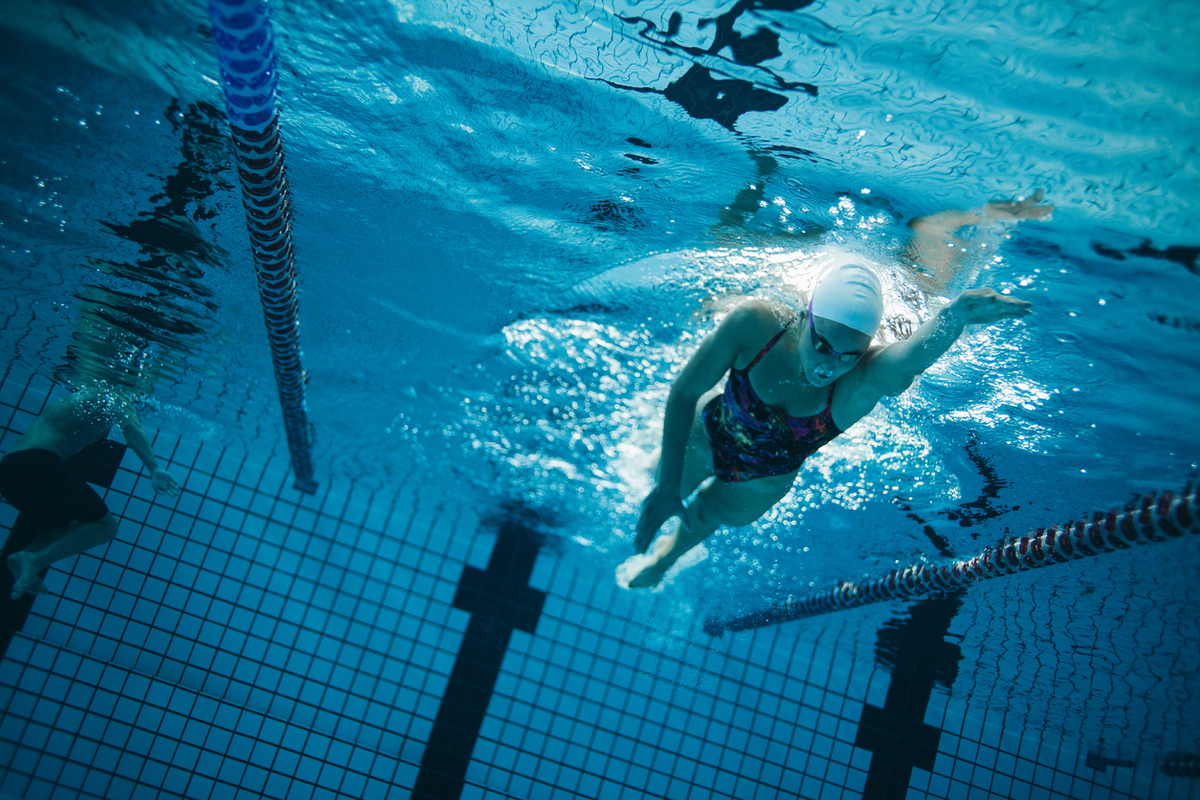
Swimming tips and training resources
Top 10 training tips for swimming

Commit to a plan

Have a routine

Safety first

Be technique focussed

Monitor your energy

Adapt to succeed

Set targets

Find your strength

Fuel and recover

Keep it social
The training triangle
Training and developing your fitness can seem complicated because different information is available. The key is the training triangle.
Most of us think the swimming training sessions are the only thing we need to do to become stronger, fitter or faster. In reality, you won’t make gains until the other two sides of the triangle, rest and nutrition, are considered.
As you increase your training, keep the triangle in balance by improving your nutrition and ensuring you listen to your body and respect its need to rest in order to improve.
Training
Your swimming, conditioning and cross training is designed to progressively overload your muscles. When they recover from that overload they will get stronger. Our training plans include a mix of different effort levels to progressively build endurance.
Rest
Your body improves and progresses during rest phases, rest days and as you sleep.
Nutrition
Fuel your training and recovery correctly to ensure you have the right nutrients to have the energy to train hard and allow your body to heal and keep your bloods, bones and immune system healthy.
Preparing for your charity swim
Before you even step into the water, there are a few things you should think about so you are as prepared as possible.
Warm up
Don't get in the pool and begin swimming lengths before you are warmed up. Start with gliding or very easy swimming to get the blood flowing and get used to the temperature and feel of the water.
Practice your breathing
After you've done some gliding, try going on your side and getting some breathing practice. Breathing is the key to a successful stroke alongside remaining relaxed.
Check the swimming pool session times
Book and choose the best time slot for you. Many swimming pools now have allocated sessions when the lanes are sectioned off. Outside of lane sessions you could be weaving in and out of other pool users which can be really frustrating.
Choosing your gear
Choose carefully and make sure you aren't just buying what looks good but what is actually practical. Take advice on what to buy. Fins and many other pieces of kit can be great for technique but get tuition on how to use them and develop your stroke.
Look after your kit
You should wash your swimming gear thoroughly after each swim to ensure that you are getting rid of the chlorine. This will help it last longer.
Waterproof your storage
Go to any DIY shop and buy one of the plastic tubs that you use for home storage or invest in a "dry bag". Throwing wet gear into one of these waterproof options is a lot more sensible than putting it into a sports bag, especially if open water training.
Wear a swimming cap
Regular use of a heavily chlorinated pool or swimming outdoors can affect your scalp. Avoid this by wearing an inexpensive swimming cap — it can make all the difference, improves hygiene and can also help with speed.
De-mist your goggles
Goggles are an essential part of swimming correctly and they can mist up if they are not looked after. Get some de-misting fluid and use it regularly before a swim. Make sure the goggles remain comfortable and don't move, being able to wear a pair for over an hour without issues is essential for long swimming events.
Improving your swimming technique
If you're already a pretty confident swimmer the information below could help tweak and improve your swimming technique and confidence.
- Practice breathing on both sides of your stroke. You may prefer to breathe on a specific side but in choppy water this might not be possible. Practice by swapping the side you breathe on as you do lengths. Breathe to your left as you go up the pool and your right when you come back down.
- Always ensure you fully exhale under the water before turning your head to the side to breathe.
- Kick your legs! Not necessarily to add momentum but to keep your hips and legs high in the water and improve your body position. Small efficient kicks are the best way to achieve this.
- Think about where your kick originates from; knees or hips? Try not to bend the legs as you kick up, aim to lift a straight leg up to the surface with your glutes (the muscles in your bum).
- Your stroke should never feel so rushed that you are uncomfortable when trying to get a breath. It is not easy to relax until your technique improves.
- When swimming a steady 400m in a 25m pool, count strokes on lengths 4,8,12 and 16. When this stroke count starts to remain constant it is a good sign that you've nailed your technique.
- As you get fitter aim for the ability to start 'even splitting' or at some point 'negative splitting' your longer swims. This means covering the second half of a swim faster than the first.
- At a more advanced level you should aim to be able to swim slow, medium and fast, yet still take a similar number of strokes per length. Increased speed should not mean a lot more strokes.
Tips for open water swimming
If your event is in open water there are a few additional things to consider before and during your event.
Before our event
Open water safety
If you're fortunate enough to have easy access to an open body of water then make sure you take advantage this. Otherwise, be on the lookout for local open water swim clinics. You can also round up a few training buddies and take a field trip to the closest body of water (ocean, lake, river, pond, etc.) and practice. Finally, this should be obvious, but in case it's not – never swim alone.
Get a wetsuit
If you don't have a wetsuit you should definitely invest in one. Make sure it is fitted correctly and speak to an expert for the best advice. Not only will it keep you warm, but more importantly it will provide extra buoyancy, helping to keep you on top of the water and making it easier to swim. This can really boost confidence. Be sure to swim in it a few times before any big event.
Goggle selection
Goggles come in in all shapes, sizes and colours to allow for different weather conditions. Making the right goggle selection will make a big difference to your vision and result in improved safety and confidence in the water. You may want several pairs so you're equipped for changing conditions.
On a cloudy or rainy day, you may choose to wear goggles with clear, light blue or yellow lenses. These will help brighten up your surroundings and make it easier to see. But if it's a bright and sunny day, mirrored or smoke lenses are your best bet.
Event day
Warm up
We recommend you warm up before all of your training swims, and race day should be no different. It is a good idea to get in the water (if you are allowed) before your wave goes off. Give yourself 10 minutes to get warm. Not only will this help get your blood flowing and prepare your body to swim, it will also give you a chance to become comfortable in the water.
Walk in slowly
Wade a bit, get a feel for the temperature and take a peak to see what the visibility is like under the water. This will all help give you reassurance and make you feel more confident of the conditions and surroundings.
Position yourself appropriately
If you're a stronger swimmer, position yourself nearer to the front. If swimming is a new event to you, head towards the back or off to the side. Once the gun goes off, take your time getting in and swim towards clear water. There is no reason to battle any chaos. It's OK to swim 10-15 yards off to the side of any buoys or course markers. Don't worry about losing a few seconds because the more comfortable you feel the better your swim will go.
Start out slow
When the gun goes off and adrenaline is pumping, a lot of swimmers tend to take off and start swimming way too fast for their ability. Often people don't realise this until about 200 yards in when their heart rate is through the roof and they're gasping for air. Try starting out much slower than race pace and gradually increase your speed as you start to get into a rhythm. This way, you'll finish strong and have a better experience. The tortoise and the hare story is so true in all endurance sports.
Cornering buoys
If this is a requirement in your event, we recommend taking as wide a route as possible. This will allow you to avoid all the pushing and shoving going on right next to the buoy due to traffic. Don't worry about the small bit of extra swimming you'll do by taking a wider turn. The energy you'll save by swimming uninterrupted will keep you feeling good and confident.
Take a break!
It's not uncommon for new swimmers to become anxious while in the open water. If this happens, don't panic. The best thing to do is pause and collect yourself for a moment. Roll onto your back, float and try to relax. This will help get your heart rate under control and calm you down. Once you're ready to start moving again, start by breast stroking. Then when you're ready, put your head down and resume swimming.
Think about fuel and hydration
This may sound obvious, but with longer swims, especially over a mile in distance, fuel becomes a real issue along with hydration. Yes, it is definitely possible to dehydrate when in water! Avoiding cramp is also key and therefore retaining your electrolyte balance becomes important.
Eat a good carbohydrate focused snack or light meal an hour or two before a longer swim session or event, and make sure you are hydrated before you start. Consider using sports drinks with electrolytes and energy in very long swims of 5-10k and taking on fuel. Have mini breaks to allow this. Even consider gels to boost energy uptake along the way every 20-40 minutes.
Relax and enjoy the open water experience
The more relaxed you are the better you will swim and try to embrace the feeling of freedom. Take your time and always stay safe.
More useful information
Now you've got the basics sorted check out how to stretch, strengthen and fuel for your swim with more top advice from our training partner Running with Us. And if you haven't already then find the perfect plan for you.


